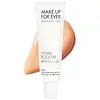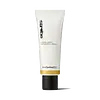What's inside
What's inside
 Key Ingredients
Key Ingredients

 Benefits
Benefits

 Concerns
Concerns

 Ingredients Side-by-side
Ingredients Side-by-side

Water
Skin ConditioningMethyl Trimethicone
Skin ConditioningPhenyl Trimethicone
Skin ConditioningIsododecane
EmollientAlcohol
AntimicrobialDimethicone
EmollientPEG-9 Polydimethylsiloxyethyl Dimethicone
EmulsifyingButylene Glycol
HumectantGlycerin
HumectantAcrylates/Dimethicone Copolymer
Skin ConditioningVinyl Dimethicone/Methicone Silsesquioxane Crosspolymer
Synthetic Fluorphlogopite
Disteardimonium Hectorite
StabilisingParfum
MaskingCaprylyl Glycol
EmollientPropylene Carbonate
SolventLecithin
EmollientSodium Benzoate
MaskingSodium Chloride
MaskingLepidium Meyenii Root Extract
Skin ConditioningMaltodextrin
AbsorbentSilica
AbrasiveCitric Acid
BufferingSodium Citrate
BufferingTin Oxide
AbrasiveCI 77163
Cosmetic ColorantCI 77891
Cosmetic ColorantCI 77491
Cosmetic ColorantCI 15850
Cosmetic ColorantWater, Methyl Trimethicone, Phenyl Trimethicone, Isododecane, Alcohol, Dimethicone, PEG-9 Polydimethylsiloxyethyl Dimethicone, Butylene Glycol, Glycerin, Acrylates/Dimethicone Copolymer, Vinyl Dimethicone/Methicone Silsesquioxane Crosspolymer, Synthetic Fluorphlogopite, Disteardimonium Hectorite, Parfum, Caprylyl Glycol, Propylene Carbonate, Lecithin, Sodium Benzoate, Sodium Chloride, Lepidium Meyenii Root Extract, Maltodextrin, Silica, Citric Acid, Sodium Citrate, Tin Oxide, CI 77163, CI 77891, CI 77491, CI 15850
Water
Skin ConditioningDimethicone
EmollientButylene Glycol
HumectantCetyl Ricinoleate
EmollientGlyceryl Distearate
EmollientTrisiloxane
Skin ConditioningGlyceryl Stearate Se
EmulsifyingCholesterol
EmollientSteareth-10
EmulsifyingSimmondsia Chinensis Seed Oil
EmollientCetyl Esters
EmollientCetyl Alcohol
EmollientTocopheryl Acetate
AntioxidantSodium Hyaluronate
HumectantCamellia Sinensis Leaf Extract
AntimicrobialMorus Bombycis Root Extract
Skin ConditioningPyrus Malus Fruit Extract
Skin ConditioningScutellaria Baicalensis Root Extract
AstringentVitis Vinifera Fruit Extract
Skin ConditioningCeramide Ng
Skin ConditioningCyanocobalamin
Skin ConditioningGlycerin
HumectantIsohexadecane
EmollientSilica
AbrasiveTin Oxide
AbrasiveSucrose
HumectantPolysorbate 80
EmulsifyingAcrylamide/Sodium Acryloyldimethyltaurate Copolymer
Emulsion StabilisingXanthan Gum
EmulsifyingCaprylyl Glycol
EmollientHexylene Glycol
EmulsifyingCitric Acid
BufferingLinoleic Acid
CleansingPanthenol
Skin ConditioningParfum
MaskingDisodium EDTA
EDTA
Magnesium Ascorbyl Phosphate
AntioxidantSodium Citrate
BufferingPhenoxyethanol
PreservativeSodium Metabisulfite
AntioxidantSodium Sulfite
PreservativeMica
Cosmetic ColorantCI 77891
Cosmetic ColorantCI 14700
Cosmetic ColorantWater, Dimethicone, Butylene Glycol, Cetyl Ricinoleate, Glyceryl Distearate, Trisiloxane, Glyceryl Stearate Se, Cholesterol, Steareth-10, Simmondsia Chinensis Seed Oil, Cetyl Esters, Cetyl Alcohol, Tocopheryl Acetate, Sodium Hyaluronate, Camellia Sinensis Leaf Extract, Morus Bombycis Root Extract, Pyrus Malus Fruit Extract, Scutellaria Baicalensis Root Extract, Vitis Vinifera Fruit Extract, Ceramide Ng, Cyanocobalamin, Glycerin, Isohexadecane, Silica, Tin Oxide, Sucrose, Polysorbate 80, Acrylamide/Sodium Acryloyldimethyltaurate Copolymer, Xanthan Gum, Caprylyl Glycol, Hexylene Glycol, Citric Acid, Linoleic Acid, Panthenol, Parfum, Disodium EDTA, EDTA, Magnesium Ascorbyl Phosphate, Sodium Citrate, Phenoxyethanol, Sodium Metabisulfite, Sodium Sulfite, Mica, CI 77891, CI 14700
 Reviews
Reviews

Ingredients Explained
These ingredients are found in both products.
Ingredients higher up in an ingredient list are typically present in a larger amount.
Butylene Glycol (or BG) is used within cosmetic products for a few different reasons:
Overall, Butylene Glycol is a safe and well-rounded ingredient that works well with other ingredients.
Though this ingredient works well with most skin types, some people with sensitive skin may experience a reaction such as allergic rashes, closed comedones, or itchiness.
Learn more about Butylene GlycolCaprylyl Glycol is a humectant and emollient, meaning it attracts and preserves moisture.
It is a common ingredient in many products, especially those designed to hydrate skin. The primary benefits are retaining moisture, skin softening, and promoting a healthy skin barrier.
Though Caprylyl Glycol is an alcohol derived from fatty acids, it is not the kind that can dry out skin.
This ingredient is also used as a preservative to extend the life of products. It has slight antimicrobial properties.
Learn more about Caprylyl GlycolCi 77891 is a white pigment from Titanium dioxide. It is naturally found in minerals such as rutile and ilmenite.
It's main function is to add a white color to cosmetics. It can also be mixed with other colors to create different shades.
Ci 77891 is commonly found in sunscreens due to its ability to block UV rays.
Learn more about CI 77891Citric Acid is an alpha hydroxy acid (AHA) naturally found in citrus fruits like oranges, lemons, and limes.
Like other AHAs, citric acid can exfoliate skin by breaking down the bonds that hold dead skin cells together. This helps reveal smoother and brighter skin underneath.
However, this exfoliating effect only happens at high concentrations (20%) which can be hard to find in cosmetic products.
Due to this, citric acid is usually included in small amounts as a pH adjuster. This helps keep products slightly more acidic and compatible with skin's natural pH.
In skincare formulas, citric acid can:
While it can provide some skin benefits, research shows lactic acid and glycolic acid are generally more effective and less irritating exfoliants.
Most citric acid used in skincare today is made by fermenting sugars (usually from molasses). This synthetic version is identical to the natural citrus form but easier to stabilize and use in formulations.
Read more about some other popular AHA's here:
Learn more about Citric AcidDimethicone is a type of synthetic silicone created from natural materials such as quartz.
What it does:
Dimethicone comes in different viscosities:
Depending on the viscosity, dimethicone has different properties.
Ingredients lists don't always show which type is used, so we recommend reaching out to the brand if you have questions about the viscosity.
This ingredient is unlikely to cause irritation because it does not get absorbed into skin. However, people with silicone allergies should be careful about using this ingredient.
Note: Dimethicone may contribute to pilling. This is because it is not oil or water soluble, so pilling may occur when layered with products. When mixed with heavy oils in a formula, the outcome is also quite greasy.
Learn more about DimethiconeGlycerin is already naturally found in your skin. It helps moisturize and protect your skin.
A study from 2016 found glycerin to be more effective as a humectant than AHAs and hyaluronic acid.
As a humectant, it helps the skin stay hydrated by pulling moisture to your skin. The low molecular weight of glycerin allows it to pull moisture into the deeper layers of your skin.
Hydrated skin improves your skin barrier; Your skin barrier helps protect against irritants and bacteria.
Glycerin has also been found to have antimicrobial and antiviral properties. Due to these properties, glycerin is often used in wound and burn treatments.
In cosmetics, glycerin is usually derived from plants such as soybean or palm. However, it can also be sourced from animals, such as tallow or animal fat.
This ingredient is organic, colorless, odorless, and non-toxic.
Glycerin is the name for this ingredient in American English. British English uses Glycerol/Glycerine.
Learn more about GlycerinParfum is a catch-all term for an ingredient or more that is used to give a scent to products.
Also called "fragrance", this ingredient can be a blend of hundreds of chemicals or plant oils. This means every product with "fragrance" or "parfum" in the ingredients list is a different mixture.
For instance, Habanolide is a proprietary trade name for a specific aroma chemical. When used as a fragrance ingredient in cosmetics, most aroma chemicals fall under the broad labeling category of “FRAGRANCE” or “PARFUM” according to EU and US regulations.
The term 'parfum' or 'fragrance' is not regulated in many countries. In many cases, it is up to the brand to define this term.
For instance, many brands choose to label themselves as "fragrance-free" because they are not using synthetic fragrances. However, their products may still contain ingredients such as essential oils that are considered a fragrance by INCI standards.
One example is Calendula flower extract. Calendula is an essential oil that still imparts a scent or 'fragrance'.
Depending on the blend, the ingredients in the mixture can cause allergies and sensitivities on the skin. Some ingredients that are known EU allergens include linalool and citronellol.
Parfum can also be used to mask or cover an unpleasant scent.
The bottom line is: not all fragrances/parfum/ingredients are created equally. If you are worried about fragrances, we recommend taking a closer look at an ingredient. And of course, we always recommend speaking with a professional.
Learn more about ParfumSilica, also known as silicon dioxide, is a naturally occurring mineral. It is used as a fine, spherical, and porous powder in cosmetics.
Though it has exfoliant properties, the function of silica varies depending on the product.
The unique structure of silica enhances the spreadability and adds smoothness, making it a great texture enhancer.
It is also used as an active carrier, emulsifier, and mattifier due to its ability to absorb excess oil.
In some products, tiny microneedles called spicules are made from silica or hydrolyzed sponge. When you rub them in, they lightly polish away dead skin layers and enhance the penetration of active ingredients.
Learn more about SilicaSodium Citrate is the sodium salts of citric acid. In skincare, it is used to alter pH levels and acts as a preservative.
Its main functions are to maintain the pH of a product and neutralize metal ions.
The acidity of our skin is maintained by our glands and skin biome; normal pH level of skin is slightly acidic (~4.75-5.5).
Being slightly acidic allows our skin to create an "acid mantle". This acid mantle is a thin barrier that protects our skin from bacteria and contaminants.
Learn more about Sodium CitrateTin Oxide is an inorganic oxide used to add opacity and volume to a product. In nature, it is already found in mineral form. The main ore of tin is an opaque and shiny mineral called casseterite.
Tin Oxide helps remove translucency in a product, or make it more opaque. Besides adding opacity, tin oxide is used for bulking to add volume.
Water. It's the most common cosmetic ingredient of all. You'll usually see it at the top of ingredient lists, meaning that it makes up the largest part of the product.
So why is it so popular? Water most often acts as a solvent - this means that it helps dissolve other ingredients into the formulation.
You'll also recognize water as that liquid we all need to stay alive. If you see this, drink a glass of water. Stay hydrated!
Learn more about Water